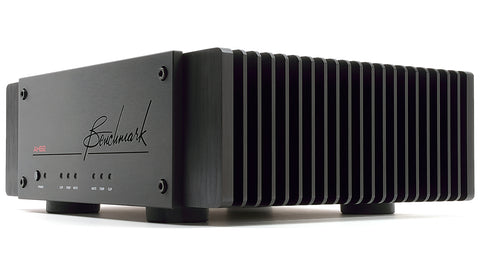Free shipping on USA orders over $700. Low-cost shipping to Canada.
Rules of Thumb for Music and Audio
by John Siau April 01, 2019

by John Siau
As an engineer I like to use "rules of thumb" to make quick estimates that help explain what can be expected from the physical world around me. These rules of thumb are easy-to-remember approximations that eliminate the need for complicated and needlessly precise calculations.
If you learn a few key rules of thumb, you can gain a tremendous understanding of the world around you. For those of you who feel discombobulated by the complexities of high school physics, there is hope! I encourage you to step back and take a fresh look at the world around you. If you learn a few simple rules of thumb, you can begin to unravel the mysteries of physics while amazing your friends and yourself.
15 Rules of Thumb for Music and Audio
In this paper I will present 15 simple rules that I find useful when working with audio. I have assigned numbers to each in order to make the discussion clearer. Memorize the rules, not the rule numbers.
Let's begin with a simple but very fundamental rule of thumb: We all know that light travels at some ridiculously fast speed, but we seem to have a hard time expressing this speed in terms of meaningful numbers. How many of you physics gurus can even remember the speed of light in MPH, ft/sec, or m/sec? OK, try this:
Rule 1: Light and electrical signals travel about 1 foot in 1 ns.
1 ns (nanosecond) is 1 billionth of a second. The exact speed of light is closer to 1.018 feet in 1 ns in a vacuum, and it is nearly the same in air. As rules of thumb go, this one is unusually precise! Electrical signals flow through a wire at a slightly slower rate, (0.5 to 0.95 times light speed), but this rule of thumb is accurate enough to include most estimates relating to electrical signals.
Let's compare the speed of light to the speed of sound:
Rule 2: Sound travels about 1 foot in 1 ms.
1 ms (millisecond) is 1 thousandth of a second. The exact number is is closer to 1.125 feet in 1 ms. This rule of thumb has more than a 12% error, but it is useful because it is easy to remember and it is accurate enough for most quick estimates. Rules of thumb do not need to be precise, they just need to be easy to use. In most quick estimates, this 12% error is not important.
The main lesson from these first two rules of thumb is that light travels about 1 million times faster than sound! This gives us our third rule of thumb:
Rule 3: Light travels 1 million times faster than sound.
Rule 3 tells me that electricity travels to my speakers about a million times faster than the sound they produce. This tells me that it is far more important to match the distance to my left and right speakers than to match the lengths of my speaker cables.
Rules 2 and 3 can Save your Life!

Rule 3 tells me that if I see a lightning strike in the distance, the time is takes for the light to arrive is insignificant. It is only 1 millionth of the time it takes for the sound to arrive. This means that I can ignore the time it takes for the light to arrive. I can estimate the distance by measuring the time it takes for the sound to arrive. I simply measure the time between seeing the flash and hearing the boom.
Rule 2 gives me the answer: Every second is about 1000 feet. Five seconds is about a mile.
Notice that I am taking the liberty of rounding a mile to 5000 feet. When making quick estimates, using rules of thumb, feel free to round the numbers and make the math easier. Remember, we use rules of thumb to make quick estimates. Keep the math as simple as possible!
For the lightning strike estimate, my rules of thumb are probably much more accurate than my ability to count the seconds from the strike. For this reason, using the exact 1,125 ft/s number is not really necessary.
Exact numbers are harder to remember and they complicate the calculations. Keep it simple, and you will gain more understanding of the world around you! The laws of physics can be simplified so that they can become a meaningful part of your daily life. When lightning is striking nearby, a quick estimate is much more useful than a precise calculation!
How do rules of thumb relate to music and audio?
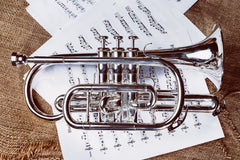
If we look at musical instruments, we can learn many things by applying Rule 2 (the speed of sound). Nothing is more central to the physics of music than the speed of sound. For example, we can create musical instruments from resonant tubes and chambers that derive their pitch from the time it takes for sound to traverse the chamber or tube. The resonant space could be a soda bottle, flute, trumpet or organ pipe. Any confined space will resonate at specific frequencies that are determined by the size of the chamber and by the speed of sound.
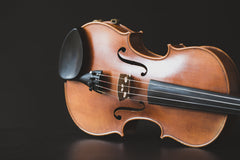
Stringed instruments often have chambers that are intended to add resonance at a wide variety of frequencies. These chambers have complex shapes so that they will have resonant modes at many different frequencies. When stimulated by a source of noise, resonant frequencies are amplified by the chamber.
Our listening rooms also form resonant chambers, and in many cases, this resonance, can detract from our listening experience. Our rules of thumb will help us to understand the resonant characteristics of our room, and they can help us identify problem frequencies. We can do this by considering three separate 2-dimensional reflection paths within the room: Front to back, side to side, and floor to ceiling.
Lets begin by constructing a simple 2-dimensional resonator with a piece of pipe. After we understand this 2-dimensional resonator, we will revisit the 3-dimensional room resonance problem.
Making Music with Pipes
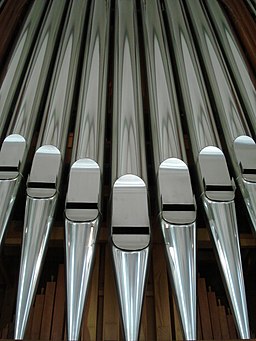 If we construct a pipe that is closed at both ends, it will resonate at a frequency that is determined by the time it takes sound to go down to the far end and reflect back to the near end. In other words, a tube with closed ends will resonate when sound travels down and back in exactly one cycle of the stimulus tone.
If we construct a pipe that is closed at both ends, it will resonate at a frequency that is determined by the time it takes sound to go down to the far end and reflect back to the near end. In other words, a tube with closed ends will resonate when sound travels down and back in exactly one cycle of the stimulus tone.
Pipe organs usually use tubes that are open at both ends. When both ends are open, the reflections still occur and tube still resonates at the same frequency.
If we build a 2-foot long organ pipe with open ends , Rule 2 tells us that it will take about 2 ms for the sound to travel down the tube and 2 ms for it to make the return trip. In the span of one second, sound can make this round trip about 250 times. This means that the tube will resonate at about 250 Hz (250 cycles per second, or 250 down and back trips per second). If we do a more precise calculation (using 1,125 ft/s) we arrive at our next rule of thumb:
Rule 4: A 2-foot open pipe resonates at 262 Hz which is middle C.
Just remember "2, 262, middle C".
If you prefer, you can round the frequency to 250 Hz whenever you want to make the math easy. 250 Hz is about midway between B and C on the piano, so you can make quick approximations and still estimate which note will be played.
Rule 4 is an old rule of thumb:
Rule 4 is clearly displayed on this pipe organ that is well over 200 years old.
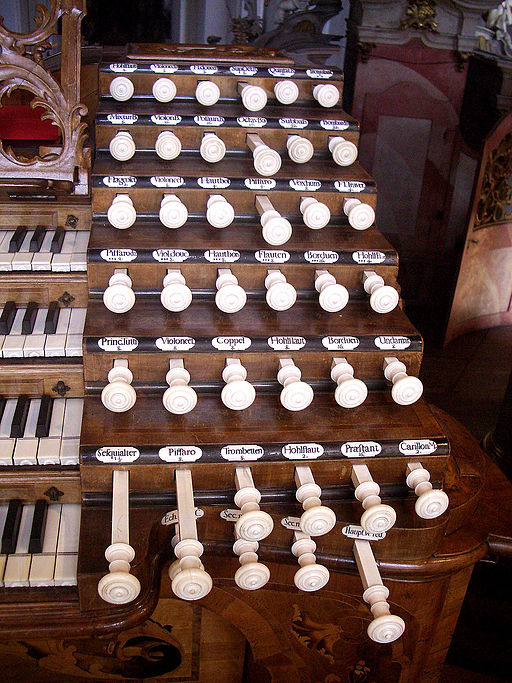 An organist or an organ builder would be very familiar with Rule 4. Most could instantly tell you that a two-foot pipe produces middle C. Pipe organ stops enable groups of pipes, which are called ranks. The stop for each rank is labeled according the approximate length of the longest pipe in the rank. Note the numbers 2, 4, 8, or 16 under the name of the various stops in the photo to the left. This German pipe organ dates from the Baroque period (17th to 18th century).
An organist or an organ builder would be very familiar with Rule 4. Most could instantly tell you that a two-foot pipe produces middle C. Pipe organ stops enable groups of pipes, which are called ranks. The stop for each rank is labeled according the approximate length of the longest pipe in the rank. Note the numbers 2, 4, 8, or 16 under the name of the various stops in the photo to the left. This German pipe organ dates from the Baroque period (17th to 18th century).
Most ranks begin with a C pipe. The lowest pipe in a "2-foot" rank plays middle C (262 Hz). A 4-foot rank begins one octave below middle C (131 Hz), an 8-foot rank begins two octaves below middle C (65.4 Hz), and a 16-foot rank begins 3 octaves below middle C (32.7 Hz). Some pipe organs include 32-foot ranks which begin 4 octaves below middle C (16.35 Hz).
There are two pipe organs in the world that include 64-foot ranks. These play a very low C at about 8.2 Hz. You must experience these organs in person to hear and feel these lower notes. In many cases, we hear the harmonics of the resonant frequency while feeling the vibrations of the fundamental. It would be difficult to build an audio system that could reproduce the experience produced by 32 and 64 foot ranks! It would also be hard to fit such a system into your living room.
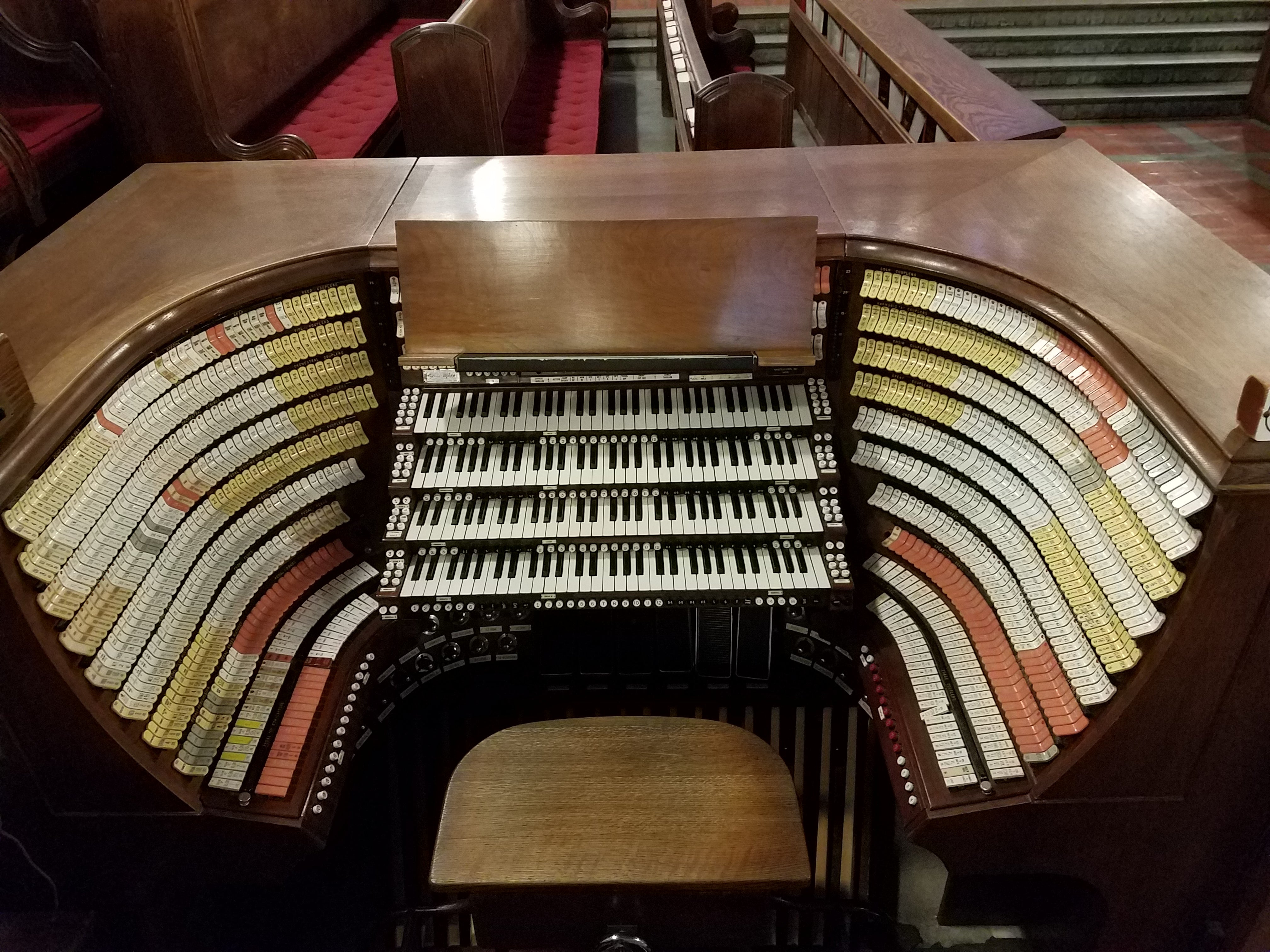
Organ Console in Cadet Chapel at West Point Military Academy - Largest chapel pipe organ in the world, 23,511 pipes - photo by John Siau
What are Harmonics?
Harmonics are integer multiples of the fundamental tone. If 10 Hz is the fundamental resonant frequency, the harmonics are 20 Hz, 30 Hz, 40 Hz, and so on. These are called the 2nd, 3rd, and 4th harmonics respectively. In our example 262 Hz (C4) is the fundamental, 524 Hz (C5) is the 2nd harmonic, and 786 Hz (G5) is the third harmonic. Pipes will resonate at harmonics of the fundamental when stimulated with harmonics.
Don't confuse harmonics with octaves.
The 2nd harmonic is one octave above the fundamental, but the 3rd harmonic is not the next octave step. The 2nd harmonic is an octave step because it is twice the frequency of the fundamental. The next doubling in frequency gives us the 4th harmonic which is two octaves above the fundamental. Another doubling in frequency will give us the 8th harmonic which is three octaves above the fundamental. If you are following the pattern here, you can see that the next octave would be the 16th harmonic. The sequence is 1, 2, 4, 8, 16, ... This group of even harmonics are perfect octaves and this makes them very musical. The remaining even harmonics (6, 10, 12, 14, 18, ...) also tend to be more musical than the odd harmonics.
Nevertheless, odd harmonics play an important part in giving musical instruments their timbre. Unique blends of odd and even harmonics give different instruments their distinct timbre. The construction of organ pipes can be varied to achieve a wide variety of sounds. A large pipe organ will have a vast selection of different sounds produced by ranks of pipes having different styles of construction. The differences in timbre can be attributed to the difference in the harmonic content produced by various types of pipes.
Most musical instruments produce significant harmonic content when a note is played. To preserve the unique timbre, audio systems must accurately reproduce these distinct harmonic patterns without adding harmonic distortion.
Exponential Changes in Size
 The main takeaway here is that the size of musical instruments change very rapidly over the range of a few octaves. Compare the size of a tuba to the size of a trumpet which plays just two octaves higher. Compare the size of a flute to the size of a piccolo. A flute is roughly 26" long and a piccolo is roughly 13" long. This 2:1 reduction in size makes a piccolo play exactly one octave higher than a flute.
The main takeaway here is that the size of musical instruments change very rapidly over the range of a few octaves. Compare the size of a tuba to the size of a trumpet which plays just two octaves higher. Compare the size of a flute to the size of a piccolo. A flute is roughly 26" long and a piccolo is roughly 13" long. This 2:1 reduction in size makes a piccolo play exactly one octave higher than a flute.
Every time the pipe length is cut in half, we increase the pitch by one octave. If we want to decrease the pitch by an octave, we will need to increase the length by a factor of two. This brings us to our next rule:
Rule 5: An octave change in pitch requires a 2:1 change in size. Bigger is lower.
Every doubling in length cuts the resonant frequency (pitch) in half. Think about our two foot long organ pipe. If we make this twice as long, the sound will need to travel twice a far for each round trip. The sound can only make half as many round trips in a given time period. In our two-foot pipe, the sound could make 262 round trips per second. In a four-foot pipe, sound can only make 131 round trips per second. 131 Hz is C3 on the piano. It is one octave lower than middle C. If we make the pipe 4 times as long, the frequency will drop by a factor of 4 which is two octaves lower.
Nobody really needed to tell you this! You learned this when you carried groceries into the house for your mom. If she parked the car twice as far away, it would take you twice as long to make each trip. You would arrive at the door less frequently. The frequency of your round trips was determined by the distance you had to travel.
Rule 6: A piano has a range that exceeds 7 octaves.

The fundamental frequencies of an 88-key piano range from a high of 4186 Hz (C8) to a low of 27.5 Hz (A0). This is a 152:1 ratio in frequency which implies a 152:1 ratio in size. This explains the size variations in musical instruments and it explains the size differences between woofers and tweeters in an audio system.
If we wish to build an organ that just matches the range of the piano, the shortest pipe would be an inch and a half long while the longest pipe would be over 8 feet long. As stated above, large pipe organs extend the low range beyond that of the piano by adding 16-foot, 32-foot or even 64-foot pipes. Pipes for high notes can be overblown so that they resonate an octave or two higher than the fundamental and this allows the use of longer pipes for some of the higher notes.
Pipe organs represent a fascinating blend between music, and engineering. Some of this engineering dates back to the 3rd century BC. Between the 17th and late 19th centuries, no man-made device was more complex than the pipe organ.
Our Rule 4 and Rule 5 were well known to the builders of these early pipe organs. We can use these same rules of thumb to analyze 3-dimensional spaces.
Estimating Room Resonant Frequencies
We can use Rule 4 and Rule 5 to estimate resonant frequencies within our listening room. Sound bounces between parallel surfaces in our room just like it bounces off of the two ends of a pipe. We have a resonator formed between the front and back walls. We have a second resonator formed between the two side walls. A third, and often forgotten resonator, is formed between the floor and the ceiling. If we are unlucky enough to have a listening room that is shaped like a cube, all three resonators will be tuned to the same fundamental frequency (and its harmonics).
Let's suppose we are unlucky and our listening room is a 10 foot cube. From Rule 4 we know that a 2 foot distance would give us a resonance at 262 Hz. We will round this to 250 Hz, just to keep the math simple.
Since 10 feet is 5 times as far as 2 feet, the resonant frequency will drop by a factor of 5 (five times as far, one fifth as many round trips per second). The resonant frequency will be approximately 250 Hz/5 = 50 Hz. 50 Hz is approximately the 9th key from the bottom of the piano keyboard. The room would also resonate at the harmonics of 50 Hz (100 Hz, 150 Hz, 200 Hz, 250 Hz ...). If you were to place a piano in your 10-foot cube, you could expect that the notes corresponding to these frequencies would sound much louder than many of the other notes on the piano. It could be difficult to enjoy listening to a piano in this cubic room.
We could try to mitigate these resonant frequencies by adding lots of absorptive material to the walls, floor, and ceiling, but this could be expensive. It also takes very thick material to absorb low frequencies. In practice, we would only be able to absorb some of the higher harmonics. It would be extremely difficult to absorb the 50 Hz fundamental resonance.

If we were building a space for listening to music, we would want to avoid building a cube. Ideally we should select dimensions that interleave the resonant frequencies. We should also avoid integer ratios between the dimensions.
We may also want to avoid creating large parallel surfaces. Most recording studios have walls and ceilings that are angled relative to each other. Studios also avoid large flat surfaces. If possible, eliminate parallel surfaces, and break up large flat surfaces. Random and irregular surfaces diffuse the reflections that would otherwise cause resonant frequencies. Absorptive materials can reduce the severity of the resonant frequencies, especially at high frequencies.
Given Rules 4 and 5, you can estimate resonant frequencies in your listening room. These simple rules will help you to determine problem frequencies in your room. If you want precise answers, there are a number of room-mode calculators on the internet that can be used to do a complete analysis of the resonant modes of a room. Many of these tools can suggest a set of dimensions. Use these tools before you build your new listening room!
Rules-of-thumb relating to loudness
As we think more about audio, it is clear that we must have some understanding of decibel units and why we use them. It turns out that our ears have an amazing dynamic range. We can hear a mosquito on the other side of the room and we can tolerate sound of a clap of thunder. There is a 1 trillion to one power ratio between these two sounds! There is actually a 10 trillion to one power ratio between the loudest sounds we can tolerate and softest sounds we can hear.
Our ears have a logarithmic response to audio power. Fortunately, a clap of thunder doesn't sound a trillion times louder than a mosquito. The logarithmic response or our ears provides us with a tremendous ability to extract details from loud and soft sounds. We could express loudness on a linear scale ranging from 1 to 10 trillion, but this would be cumbersome and hard to decipher. For this reason, logarithmic units are usually the best choice for audio loudness measurements, calculations, and specifications. 130 dB is an easy way to express the 10,000,000,000:1 power ratio that corresponds to the dynamic range of the human ear. As we explore the concept of decibels (dB), we will discover some very useful rules of thumb:
Rule 7: 0 dB SPL is the threshold of normal hearing.
A sound at 0 dB SPL is just loud enough to be heard. It is roughly equivalent to the sound of a mosquito flying 10 feet (3 m) away. This threshold of hearing is frequency dependent and listener dependent. Most listeners with normal hearing have maximum sensitivity at about 3 kHz. This sensitivity tapers off above and below 3 kHz. Use the 0 dB SPL threshold for quick approximations of audibility especially when considering mid-range sounds.
SPL is an abbreviation for sound pressure level. It is measured in dB relative to a reference pressure level that corresponds to the threshold of hearing.
Rule 8: 130 dB SPL is about the highest peak loudness that we can tolerate.
Very brief exposures at this level can cause permanent hearing damage. OSHA allows less than 2 minutes of exposure per work day at 130 dB SPL. The threshold of pain may be as high as 140 dB for some listeners but this threshold also varies with frequency. Curiously, the threshold of pain tends to get lower after our ears have sustained permanent damage. Some listeners may experience pain at much lower levels.
In the context of a home audio system, there is no sane reason for having the ability to produce peak sound pressure levels above 130 dB SPL at the listening position. If your sound system is hitting your ears with 130 dB SPL on very short peaks it is almost certainly playing at ear-damaging levels.

In a very large room or an outside venue, a sound system may need to produce sounds above 130 dB SPL (at the speakers) in order to achieve reasonable levels at the listening position.
Rule 9: A 1 dB change in loudness is a just noticeable difference (JND).
At mid loudness levels, a 1-dB change in loudness is just noticeable. A 1-dB increase requires a 25% increase in power. At higher loudnesses, changes as small as 1/3 dB may be noticeable. The JND threshold also varies with frequency. Nevertheless 1 dB is a good rule of thumb.
Benchmark products have volume controls with 1/2 dB steps. This allows an adjustment in level that is just noticeable. Smaller steps would serve no useful purpose.
Rule 10: A 3 dB increase in loudness requires a 2X increase in power.
A 200 W power amplifier is just 3 dB louder than a 100 W amplifier.
Rule 11: A 6 dB increase in loudness requires a 4X increase in power which is a 2X increase in voltage.
A stereo amplifier running in bridged mono mode will produce twice the voltage and can produce up to four times the power into a given load. The Benchmark AHB2 power amplifier is about 6 dB louder when running in bridged mono mode.
Rule 12: A 10 dB increase in loudness requires a 10X increase in power.
From this we can see that a 100 W amplifier will play 10 dB louder than a 10 W amplifier.
Rule 13: In a home environment, the SPL at the listening position is about the same as the 1m response of the speaker in an anechoic chamber.
If a speaker has a measured output of 90 dB SPL at 1 meter when fed with one watt, you can expect about 90 dB SPL at your listening position when driving your speaker with one watt. Room reflections supplement the output of the speakers and compensate for the fact that you are more than 1 meter from your speakers. If you are outdoors, this rule does not apply. But, in a typical home listening room, the rule works reasonably well for a quick approximation.
Rule 14: Every bit in a digital system adds 6 dB to the signal to noise ratio (SNR) of the digital channel.
The actual formula is (6.02 dB * n) + 1.76 dB where n is the number of bits. Subtract 4.77 dB if TPDF dither is used. This means that a 16-bit system provides a SNR of between 93.31 and 98.08 dB depending upon the use of dither. Our rule of thumb gives us 96 dB which is right in the middle of this range. In all cases, adding 1 bit increases the SNR of the digital channel by exactly 6.02 dB when it is measured over the entire bandwidth of the digital channel. Don't get bogged down in the details, the 6 dB per bit approximation is a very good rule of thumb.
Rule 15: The bandwidth of a digital system is 1/2 of the sample rate.
The 44.1 kHz sample rate used on CDs provides a 0 Hz to 22.05 kHz frequency range. Frequencies above 22.05 kHz cannot be recorded on a CD. One half of the sample rate is also known as the Nyquist frequency. Frequencies below the Nyquist frequency can be digitized and reproduced accurately.
Use your rules of thumb to check high-precision calculations!
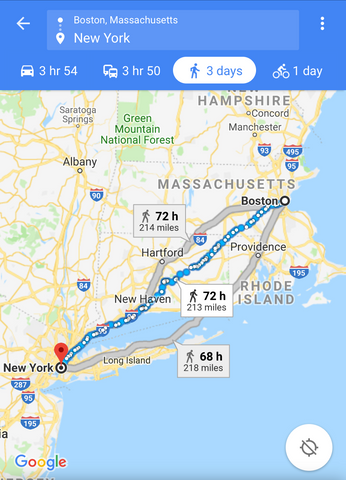
It is easy to make mistakes when using a computer to make precise calculations. Check your work against quick estimates based upon rules-of-thumb that you have memorized or learned through experience.
Is the calculated result about what you expected?
If your precise calculations differ from your quick estimates by more than a reasonable margin, it is time to go back and check the math.
For example, if you want to travel from Boston to New York, you may know from experience that this should take about 4 hours. From prior experience, you have developed a rule of thumb for trips between these two cities. If you plug this trip into Google maps and get 72 hours, you know something is wrong! It could be that Google thinks you are walking. Click on the car icon and try again.
- John SIau
Printable Version:
Also in Audio Application Notes

How Loud is the Distortion from Your Power Amplifier?
by John Siau August 08, 2025
Would you put a Washing Machine in your Listening Room?
If the answer is no, you may be surprised to discover that the distortion produced by your power amplifier may be louder than the noise produced by a major appliance.
Don't believe me? Take a look at Stereophile's test reports:
We selected 7 power amplifiers from Stereophile's top list of recommended amplifiers.
We took Stereophile's "THD+N vs. Power" plots for each, and replotted the data in a format that shows the loudness of the THD+N at the listening position.
The results are shocking!
Amplifier THD+N is louder than expected!
The distortion from your amplifier may be louder than a washing machine on the spin cycle, or it may be totally silent. How does yours perform? The answer is hidden in Stereophile's THD+N plots.
This application note reveals the hidden truth:
"The Distortion from your Power Amplifier may be Louder than a Washing Machine!"
I know, it sounds crazy, but this is what the measurements show!

Interpolator Overload Distortion
by John Siau November 20, 2024
Most digital playback devices include digital interpolators. These interpolators increase the sample rate of the incoming audio to improve the performance of the playback system. Interpolators are essential in oversampled sigma-delta D/A converters, and in sample rate converters. In general, interpolators have vastly improved the performance of audio D/A converters by eliminating the need for analog brick wall filters. Nevertheless, digital interpolators have brick wall digital filters that can produce unique distortion signatures when they are overloaded.
10% Distortion
An interpolator that performs wonderfully when tested with standard test tones, may overload severely when playing the inter-sample musical peaks that are captured on a typical CD. In our tests, we observed THD+N levels exceeding 10% while interpolator overloads were occurring. The highest levels were produced by devices that included ASRC sample rate converters.

Audiophile Snake Oil
by John Siau April 05, 2024
The Audiophile Wild West
Audiophiles live in the wild west. $495 will buy an "audiophile fuse" to replace the $1 generic fuse that came in your audio amplifier. $10,000 will buy a set of "audiophile speaker cables" to replace the $20 wires you purchased at the local hardware store. We are told that these $10,000 cables can be improved if we add a set of $300 "cable elevators" to dampen vibrations. You didn't even know that you needed elevators! And let's not forget to budget at least $200 for each of the "isolation platforms" we will need under our electronic components. Furthermore, it seems that any so-called "audiophile power cord" that costs less than $100, does not belong in a high-end system. And, if cost is no object, there are premium versions of each that can be purchased by the most discerning customers. A top-of-the line power cord could run $5000. One magazine claims that "the majority of listeners were able to hear the difference between a $5 power cable and a $5,000 power cord". Can you hear the difference? If not, are you really an audiophile?


